Apple 5300 User Manual

Macintosh PowerBook
User’sGuide
Includes setup, troubleshooting, and important health-related information for Macintosh PowerBook 5300 series computers
K Apple Computer, Inc.
© 1995 Apple Computer, Inc. All rights reserved.
Under the copyright laws, this manual may not be copied, in whole or in part, without the written consent of Apple. Your rights to the software are governed by the accompanying software license agreement.
The Apple logo is a trademark of Apple Computer, Inc., registered in the U.S. and other countries. Use of the “keyboard” Apple logo (Option-Shift-K) for commercial purposes without the prior written consent of Apple may constitute trademark infringement and unfair competition in violation of federal and state laws.
Every effort has been made to ensure that the information in this manual is accurate. Apple is not responsible for printing or clerical errors.
Apple Computer, Inc. 1 Infinite Loop
Cupertino, CA 95014-2084 (408) 996-1010
Apple, the Apple logo, AppleLink, AppleShare, AppleTalk, LaserWriter, Macintosh, PowerBook, and StyleWriter are trademarks of Apple Computer, Inc., registered in the U.S. and other countries.
Apple Desktop Bus, Balloon Help, Chicago, Disk First Aid, eWorld, Finder, Mac, and PowerTalk are trademarks of Apple Computer, Inc.
Adobe, Adobe Illustrator, Adobe Photoshop, and PostScript are trademarks of Adobe Systems Incorporated, which may be registered in certain jurisdictions.
Linotype and Times are registered trademarks of Linotype-Hell AG.
PowerPC and the PowerPC logo are trademarks of International Business Machines Corporation, used under license therefrom.
SuperPaint is a trademark of Aldus Corporation, a subsidiary of Adobe Systems Incorporated, which may be registered in certain jurisdictions.
Simultaneously published in the United States and Canada.
Mention of third-party products is for informational purposes only and constitutes neither an endorsement nor a recommendation. Apple assumes no responsibility with regard to the performance or use of these products.

Contents
|
Communications regulation information |
vii |
|||||
Preface |
Welcome to PowerPC |
ix |
|
|
|
||
|
|
|
|
|
|
|
|
Part I |
|
|
|
|
|
|
|
1 |
Getting Started |
1 |
|
|
|
|
|
|
Plugging in the computer |
1 |
|
|
|
||
|
Opening the display |
4 |
|
|
|
|
|
|
Turning the computer on |
6 |
|
|
|
||
|
Problems turning the computer on? |
8 |
|
||||
|
Making software disks |
9 |
|
|
|
||
|
What’s next? |
15 |
|
|
|
|
|
|
Learning the basics |
16 |
|
|
|
|
|
|
Reviewing the basics |
18 |
|
|
|
||
|
Turning the computer off |
19 |
|
|
|
||
|
Putting the computer to sleep |
20 |
|
|
|||
|
Restarting a computer that’s already on |
|
22 |
||||
|
Where to find answers |
24 |
|
|
|
||
iii

2 Getting Help |
25 |
|
|
Getting answers to your questions |
26 |
||
Identifying objects on the screen |
34 |
||
Learning useful shortcuts |
35 |
|
|
3 Using Expansion Bay Modules and PC Cards |
37 |
||||
Using expansion bay modules 37 |
|
|
|||
Using PC Cards (PCMCIA cards) |
41 |
|
|
||
4 Connecting Additional Equipment |
51 |
|
|||
Connecting a printer |
52 |
|
|
|
|
Connecting an external modem |
53 |
|
|
||
Connecting SCSI devices |
54 |
|
|
|
|
Connecting an external monitor |
59 |
|
|
||
Connecting sound input and output devices 63 |
|
||||
Connecting other devices |
64 |
|
|
|
|
Adding memory to your computer |
64 |
|
|
||
5 Installing and Using Application Programs |
65 |
||||
Using Software Highlights |
65 |
|
|
|
|
Getting help for application programs |
67 |
|
|||
Installing application programs |
67 |
|
|
||
Working with several programs at a time |
68 |
|
|||
Backing up your files |
69 |
|
|
|
|
Using “native” application programs 70 |
|
||||
iv Contents

6 |
Power Management |
71 |
|
|
Power sources 71 |
|
|
|
Monitoring the battery charge |
71 |
|
|
Recharging the battery |
74 |
|
|
Removing or replacing the battery 75 |
||
|
Maximizing work time |
76 |
|
|
|
|
|
Part II |
|
|
|
7 |
Tips and Troubleshooting |
79 |
|
When you have questions |
79 |
|
|
|
|
When you run into trouble |
79 |
|
|
|
|
Problems starting up the computer |
|
80 |
|
|
|
Problems working with programs |
|
85 |
|
|
|
Other problems while working |
89 |
|
|
|
|
Problems with hardware |
92 |
|
|
|
|
Problems with equipment connected to your computer |
100 |
||||
Problems with networks and file sharing |
101 |
|
|||
Problems with Apple Remote Access |
104 |
|
|
||
8 Diagnostic Techniques |
|
107 |
|
Checking your system software extensions |
107 |
||
Testing your hard disk |
109 |
|
|
Reinstalling system software |
111 |
|
|
Contents v

Part III |
|
|
|
|
|
A |
Health, Safety, and Maintenance Tips |
121 |
|
||
|
Health-related information about computer use |
121 |
|||
|
Important care and safety instructions |
|
127 |
|
|
|
Caring for batteries |
129 |
|
|
|
|
Handling floppy disks |
130 |
|
|
|
|
Traveling with the Macintosh PowerBook |
131 |
|
||
|
Storing the Macintosh PowerBook |
133 |
|
|
|
|
Service and support |
133 |
|
|
|
B |
Using Your Keyboard |
135 |
|
|
Typing special characters and symbols 135 |
||
|
Special key combinations |
137 |
|
C |
Installing a Macintosh PowerBook RAM Expansion Card 141 |
||
|
Getting ready 142 |
|
|
|
Installing the card 142 |
|
|
|
Checking to see the card is properly installed 160 |
||
|
Index |
161 |
|
vi Contents

Communications regulation information
FCC statement
This equipment has been tested and found to comply with the limits for a Class B digital device in accordance with the specifications in Part 15 of FCC rules. See instructions if interference to radio or television reception is suspected.
Radio and television interference
The equipment described in this manual generates, uses, and can radiate radio-frequency energy. If it is not installed and used properly—that is, in strict accordance with Apple’s instructions—it may cause interference with radio and television reception.
This equipment has been tested and found to comply with the limits for a Class B digital device in accordance with the specifications in Part 15 of FCC rules. These specifications are designed to provide reasonable protection against such interference in a residential installation. However, there is no guarantee that interference will not occur in a particular installation.
You can determine whether your computer system is causing interference by turning it off. If the interference stops, it was probably caused by the computer or one of the peripheral devices.
If your computer system does cause interference to radio or television reception, try to correct the interference by using one or more of the following measures:
mTurn the television or radio antenna until the interference stops.
mMove the computer to one side or the other of the television or radio.
mMove the computer farther away from the television or radio.
mPlug the computer into an outlet that is on a different circuit from the television or radio. (That is, make certain the computer and the television or radio are on circuits controlled by different circuit breakers or fuses.)
If necessary, consult an Apple-authorized service provider or Apple. See the service and support information that came with your Apple product. Or, consult an experienced radio/television technician for additional suggestions. You may find the following booklet helpful: Interference Handbook (stock number 004-000-00493-1). This booklet, prepared by the Federal Communications Commission, is available from the U.S. Government Printing Office, Washington, DC 20402.
IMPORTANT Changes or modifications to this product not authorized by Apple Computer, Inc., could void the FCC Certification and negate your authority to operate the product.
This product was tested for FCC compliance under conditions that included the use of Apple peripheral devices and Apple shielded cables and connectors between system components. It is important that you use Apple peripheral devices and shielded cables and connectors between system components to reduce the possibility of causing interference to radios, television sets, and other electronic devices. You can obtain Apple peripheral devices and the proper shielded cables and connectors through an Apple-authorized dealer. For non-Apple peripheral devices, contact the manufacturer or dealer for assistance.
Communications Regulation Information |
vii |

DOC statement
DOC Class B Compliance This digital apparatus does not exceed the Class B limits for radio noise emissions from digital apparatus as set out in the interference-causing equipment standard entitled “Digital Apparatus,” ICES-003 of the Department of Communications.
Observation des normes—Classe B Cet appareil numérique respecte les limites de bruits radioélectriques applicables aux appareils numériques de Classe B prescrites dans la norme sur le matériel brouilleur: “Appareils Numériques”, NMB-003 édictée par le ministre des Communications.
VCCI statement
viii Communications Regulation Information

Welcome to PowerPC
Congratulations on the purchase of your new Macintosh PowerBook computer. Your computer is designed to give you the highest performance combined with real ease of use—it’s easy to set up, easy to use, and easy to expand. This book will guide you through the setup procedure, tell you how to expand your computer, and provide many tips on using your new system.
Your computer is powered by the new † microprocessor (or “chip”). This microprocessor was designed by Apple Computer, Inc., Motorola, Inc., and IBM Corporation. The † microprocessor uses Reduced Instruction Set Computing (RISC) technology to deliver very high performance at the lowest possible cost. The † RISC microprocessor represents the state of the art in microprocessor design.
Your new computer will run almost all your existing Mac OS software, but for best performance and greatest speed, look for the new software programs designed especially for computers with PowerPC microprocessors. You’ll find these programs at any software store that carries Mac OS products.
ix

Chapter 1 |
Getting Started |
Chapter 2 |
Getting Help |
Chapter 3 |
Using Expansion Bay Modules and PC Cards |
Chapter 4 |
Connecting Additional Equipment |
Chapter 5 |
Installing and Using Application Programs |
Chapter 6 |
Power Management |
partI


Follow the instructions in this
chapter to set up your computer
and learn the basics.
1 Getting Started
The illustration on the next page provides an overview of your Macintosh PowerBook computer. To set up your computer for the first time, you need the power adapter and the power cord that came with it.
When setting up your computer, place your computer on a sturdy, flat surface near a grounded electrical outlet. Before following the setup instructions in this chapter, you may want to read “Arranging Your Work Area and Equipment” in Appendix A for tips on adjusting your work furniture and computer so that you’re comfortable when using the computer.
1

Speaker
Trackpad
Trackpad button
Infrared window
™ Video port
IReset button
à Sound input port
Sleep indicator
¤ Brightness control
O Contrast control
Microphone
P Power key
Floppy disk drive module
Expansion bay drive in-use light
Security slot
Battery
Card storage module
Two PC Card (PCMCIA card) slots
PC Card eject buttons
Elevation foot release button
¯ Power adapter port
Elevation feet
V Apple Desktop Bus (ADB) port
- Sound output port |
g SCSI port (HDI-30) |
´ Printer/External modem port |

Plugging in the computer
Plugging in the power adapter recharges the computer’s battery. You should plug in the power adapter in case the battery has drained during shipping or storage.
WARNING Use only the power adapter that came with your Macintosh PowerBook computer. Adapters for other electronic devices (including other Macintosh PowerBook models and other portable computers) may look similar, but they may damage your computer.
When you are ready to begin, follow these steps:
1Plug one end of the power cord into the power adapter and the other end into a threehole grounded outlet or power strip.
WARNING This equipment is intended to be electrically grounded. The power adapter that came with your Macintosh PowerBook is equipped with a three-wire grounding plug—a plug that has a third (grounding) pin. This plug will fit only a grounded AC outlet. This is a safety feature. If you are unable to insert the plug into the outlet, contact a licensed electrician to replace the outlet with a properly grounded outlet. Do not defeat the purpose of the grounding plug!
Getting Started |
3 |
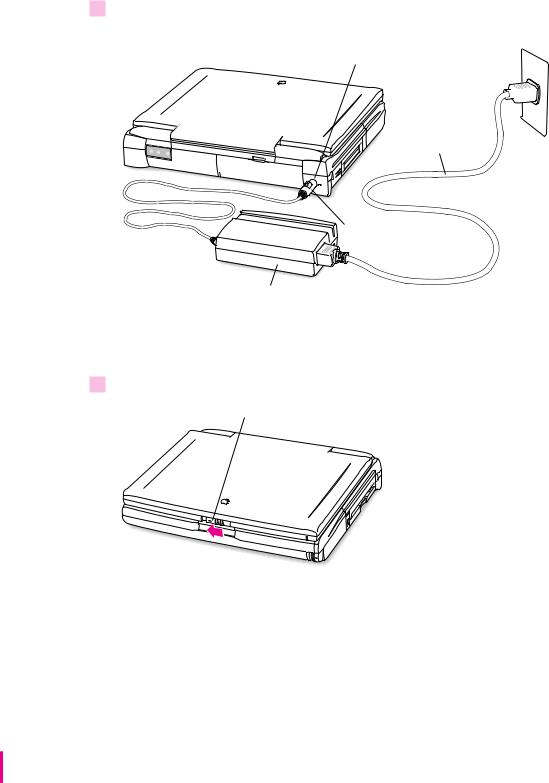
2Plug the power adapter plug into the power adapter port (marked with the icon ¯) on the back panel of the computer.
¯Power adapter port
Power cord
Power adapter plug
Power adapter
Opening the display
1 Slide the latch to the left and lift up the display.
Slide the latch to the left to open the display.
4 Chapter 1
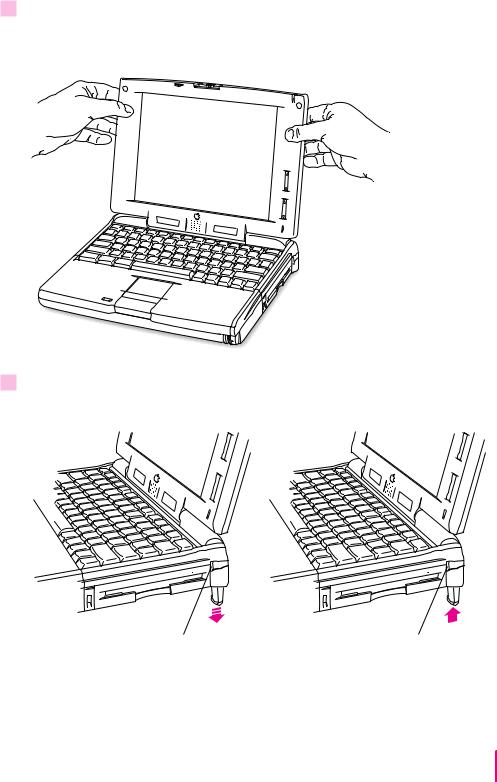
2Position the display at a comfortable viewing angle.
You can adjust the angle of the display at any time by tilting it toward or away from you.
3Adjust the elevation feet to raise the computer.
The back of the keyboard is slightly elevated when the feet are in use.
To lower the foot, press the release button. The foot extends automatically.
To raise the foot, press the release button while pushing up on the foot until it clicks into place.
It is a good idea to lower the elevation feet whenever you are using your computer on a flat surface.
Getting Started |
5 |
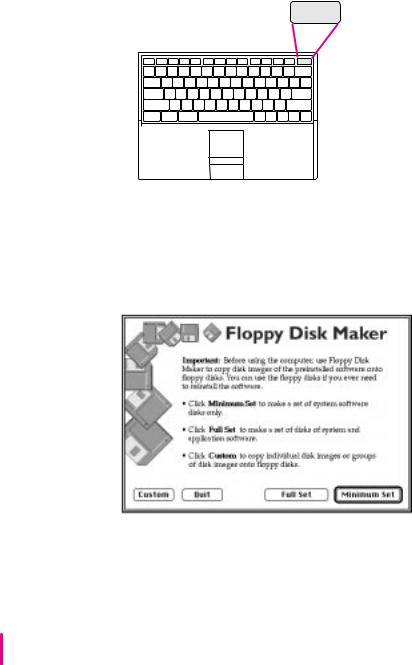
Turning the computer on
To turn on the computer for the first time:
mPress the Power key (marked with a P) at the upper-right corner of the keyboard to turn the computer on.
Power key
¹
You should hear a tone when you turn on the computer. It takes the computer a few minutes to start up. You’ll see the Mac OS startup screen as the system software is loaded on the computer.
After your computer starts up for the first time, a picture similar to this appears on the screen:
If you don’t see this picture on your screen, go to the next section, “Problems Turning the Computer On?”
6 Chapter 1
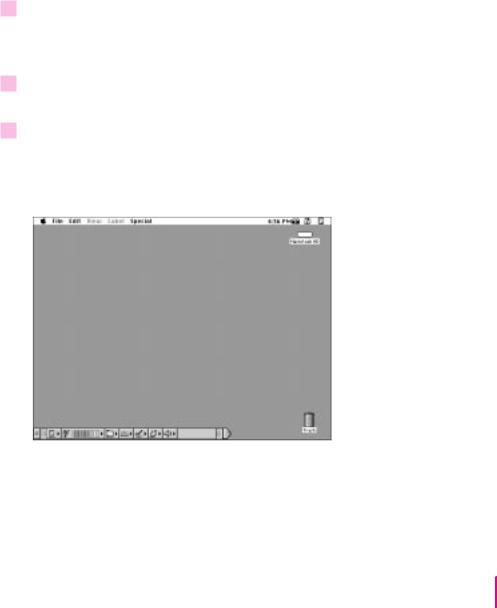
If you are a new Macintosh PowerBook user, follow the instructions in the rest of this section. If you have experience using a Macintosh computer, skip to “Making Software Disks” later in this chapter to learn how to make floppy disks of the software installed on your computer.
If you are a new Macintosh PowerBook user
If you have no experience using a Macintosh PowerBook computer, you need to learn how to use your computer before you can make your disks. Follow these steps:
1Move your finger on the trackpad to move the arrow pointer (8) on the screen.
Place your index finger on the trackpad and your thumb on the trackpad button. Don’t press the trackpad button yet.
2Move your finger on the trackpad so that the tip of the arrow (8) is inside the Quit button at the bottom of the Floppy Disk Maker box.
3Being careful not to move your finger on the trackpad, press and release the trackpad button.
The Floppy Disk Maker box no longer appears. Instead, you see the following picture:
Note: Your screen should look very similar to this, but it may not look exactly the same.
Getting Started |
7 |
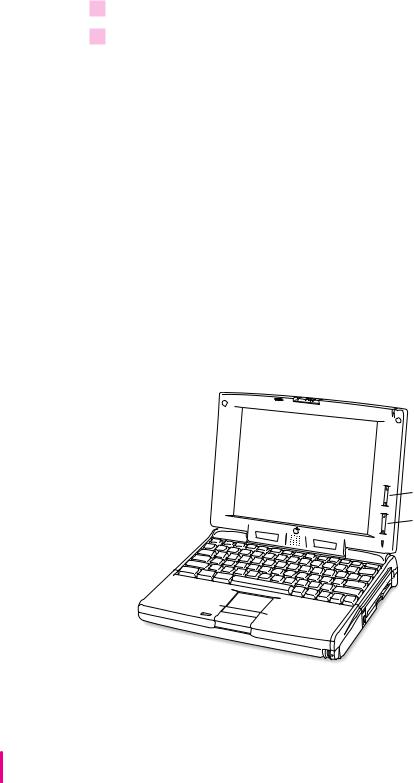
4Turn to the “Learning the Basics” section later in this chapter.
5Turn to “Making Software Disks” as soon as you are done learning the basics.
It is very important that you make your floppy disks as soon as you are done with the first part of the Macintosh Tutorial.
Problems turning the computer on?
mNothing happened when you pressed the Power key.
The battery may be drained. Make sure you plug in the power adapter, and that the power adapter is firmly connected to both the computer and a power source. If the power adapter is plugged into a power strip, make sure the power strip is plugged in and turned on. Then try pressing the
key again.
If the computer still doesn’t turn on, see “Problems Starting Up the Computer” in Chapter 7.
mThe computer made a sound, but you can’t see anything on the screen.
Adjust the brightness control (marked with the icon ¤) and contrast control (O) until an image appears and the screen is easy to read.
¤ Brightness control
O Contrast control
8 Chapter 1

mYou see a picture of a disk with a blinking question mark on the screen.
This icon usually means that the computer can’t find system software on the hard disk or any disks attached to the computer. You may need to reinstall system software. See “Reinstalling System Software” in Chapter 8.
mYou don’t see the Floppy Disk Maker picture on the screen.
The screen for Floppy Disk Maker appears when you start up your computer until you make a minimum set of disks. If you haven’t made a minimum set of disks, see the next section, “Making Software Disks.”
(Note: The screen that appears for Floppy Disk Maker may be slightly different from the screen shown in this manual.)
Making software disks
This section describes how to create floppy disks of the software that comes on your computer.
Why make software disks?
Your Macintosh PowerBook computer comes with different kinds of software installed. System software is the set of programs and other files that your computer uses to start itself up, keep track of your files, and run application programs. When you turn on your computer, it looks for a disk that contains the system software. System software is always in a folder called the
System Folder.
Other included software gives you added functionality on your computer.
You need to make a copy of this software for safekeeping, in case you ever need to reinstall the software on your computer. The disks you need to install and reinstall software from are called installer disks. You use the Floppy Disk Maker application program to create your software installer disks.
Getting Started |
9 |
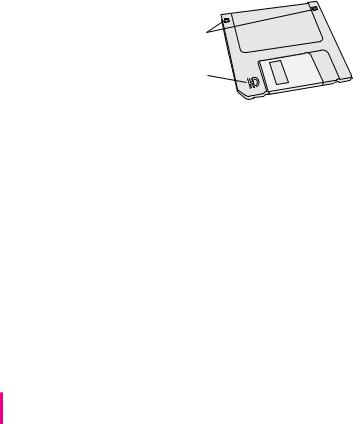
What is a disk image?
A disk image is a discrete electronic representation of an individual disk. The Disk Images folder in the Floppy Disk Maker folder on your hard disk contains the disk images you need to create installer disks for both your system software and the other software that comes on the hard disk. When
you use Floppy Disk Maker, it copies the disk images onto floppy disks. When you are finished making a set of disks with Floppy Disk Maker, you’ll have a set of installer disks and will be able to reinstall the software that comes on your computer.
What you need
Just as you need paper to make copies of important documents, you need floppy disks to make copies of the information on your hard disk. You can probably buy the floppy disks at the same place you bought your computer.
Floppy disks come in a variety of sizes and capacities. The ones you need for backing up your hard disk are called high-density 3.5-inch disks. You can recognize the disks by the way they look:
High-density disks
have two holes...
...and they have this symbol.
Even though these disks have a hard plastic casing, they are called “floppy disks” because the disk inside the casing is floppy.
Before you start making your disks, you’ll need to decide if you want to make a full set or a minimum set of disks. When you make a full set, you’ll make disks for your system software and most of the other software that comes on your computer. When you make a minimum set, you’ll make just the core system software disks. It is best to make a full set, so you’ll have installer disks for your system software and most of the other software that comes on your computer. However, making a full set requires more disks and more time than making a minimum set. At the very least, make a minimum set of disks now. If you choose to make a minimum set, you can make disks for the other software later.
10 Chapter 1
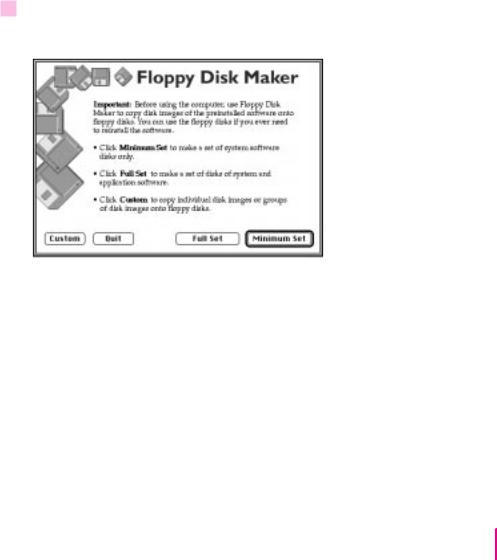
If you don’t have disks on hand, you can skip these instructions for the moment. But the sooner you make the system software disks, the better. Buy the disks as soon as possible, then return to this section and follow these instructions.
IMPORTANT Be sure you make at least a minimum set of disks as soon as possible, in case you need to reinstall your system software.
Making a set of disks
To use the Floppy Disk Maker program to make your system software disks, follow these instructions:
1If your computer is off, turn it on.
Before you can begin, the following dialog box should be on your screen:
This dialog box will appear every time you start your computer until you make at least a minimum set of disks. It is very important that you make at least a minimum set. (You can turn this feature off by removing the Floppy Disk Maker alias from the Startup Items folder in the System Folder. See “Problems Starting Up the Computer” in Chapter 7 for more information.)
If you clicked the Quit button in the Floppy Disk Maker dialog box, you can find Floppy Disk Maker in either the Applications/Utilities section of Software Highlights or in the Floppy Disk Maker folder (inside the Utilities folder) on your hard disk. (See “Using Software Highlights” in Chapter 5 for more information.)
Getting Started |
11 |
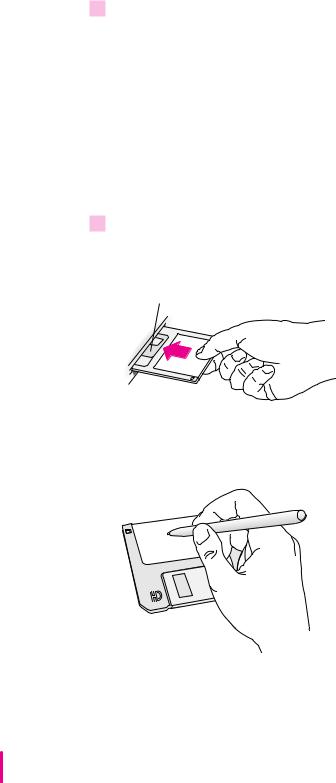
2Click Minimum Set or Full Set, depending on the kind of disk set you want to make.
If you are making a minimum set, you can press the Return key. You can make a minimum set first so you have a set of system software disks, and then use Floppy Disk Maker to make the other disks later. (See “Making Individual Disks,” later in this chapter, for instructions when you want to make the additional disks.)
If you need to stop Floppy Disk Maker in the middle of making a set of disks, click Quit. Floppy Disk Maker will remember where you were in the diskmaking process, and will resume where you left off when you restart Floppy Disk Maker.
3Follow the instructions on the screen until a message tells you that you’re finished.
Insert a new disk whenever the screen messages tell you to. Do not use the Disk Tools floppy disk that came with your computer.
Insert the disk metal end first, label side up.
As you complete each disk, make a label with the name displayed on the screen. Then immediately put the label on the disk so that you know what its contents are later.
12 Chapter 1

4When you’re finished, click Quit.
If you want to make more disks, click Continue and go to the next section, “Making Individual Disks,” to learn about using Floppy Disk Maker’s custom feature.
Be sure the floppy disks are properly labeled, then store them in a safe, cool place.
5If you quit in the middle of the disk-making process and want to resume copying, click Resume Minimum or Resume Full (depending on the type of set you are making) when you see the Floppy Disk Maker box.
Once you’ve made a full set of disks, you can delete the disk images to free up space on your hard disk. However, keeping copies of at least the system software images is a good idea. You should keep these disk images on your hard disk, or backed up on an external hard disk or PC Card (PCMCIA card). The disk images are found in a folder called Disk Images inside the Floppy Disk Maker folder.
Making individual disks
If you made a minimum set of disks, you can go back and make disks of the remaining software on your computer. You do this by using the custom feature of Floppy Disk Maker. You can make an individual disk or a set of disks for an application program. Follow these steps:
1Open the Floppy Disk Maker application program.
You can find Floppy Disk Maker in either the Applications/Utilities section of Software Highlights or in the Floppy Disk Maker folder (inside the Utilities folder) on your hard disk. (See “Using Software Highlights” in Chapter 5 for more information.)
Getting Started |
13 |
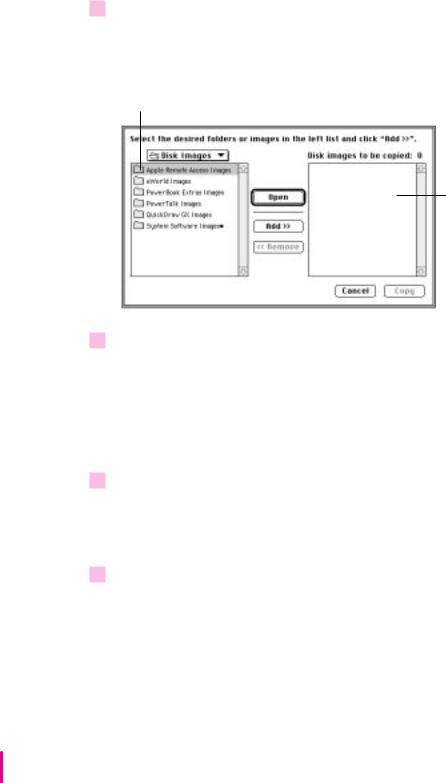
2 When the Floppy Disk Maker dialog box appears, click Custom.
The following appears on the screen:
Folders containing images of software that comes on your computer are listed here. Click the folder you want to copy, then click Add.
Once you add the folders you want to copy, they appear here.
3Click the icon for the folder you want to copy to select it.
If you want to make one individual disk for a program (in case you lost a disk or an individual disk got damaged), double-click the program’s folder to open it, then click the icon of the individual disk image to select it.
The folder (or individual disk) appears in the list to the right under “Disk images to be copied.”
4Click Add.
Repeat steps 3 and 4 until all the software you want to copy appears in the list to the right. The total number of disks you’ll need appears above the list in the right of the window.
5Click Copy.
Follow the instructions on the screen. Remember to label the disks as you make them.
14 Chapter 1

What’s next?
You’ve now finished setting up your Macintosh PowerBook. Continue with one of the following steps:
mIf you are new to the Macintosh, turn to the next section, “Learning the Basics.”
mIf you are an experienced Macintosh user, turn to Chapter 2, “Getting Help,” to learn about Macintosh Guide, your main source of information when you’re working with the Macintosh computer.
mIf you have additional equipment to connect to your computer, see Chapter 4, “Connecting Additional Equipment,” for instructions. (If you are a new Macintosh user, you should complete “Learning the Basics” before connecting additional equipment.)
mIf you have application programs that you want to install on your computer, see Chapter 5, “Installing and Using Application Programs,” for instructions. (If you are a new Macintosh user, you should complete “Learning the Basics” before installing application programs.)
IMPORTANT If you need to turn off your computer at any point, read the instructions in “Turning the Computer Off” later in this chapter to learn the correct procedure for turning off your Macintosh PowerBook computer.
Getting Started |
15 |
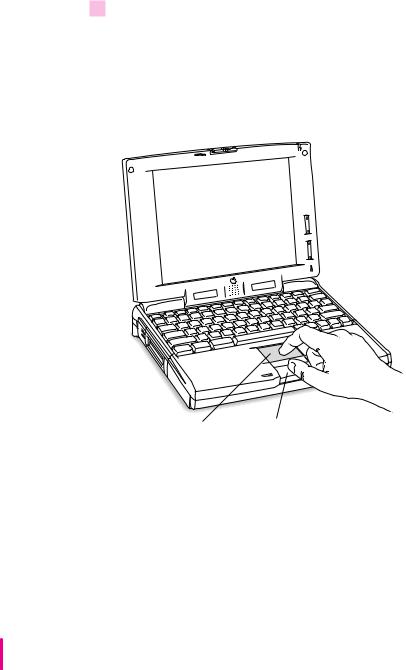
Learning the basics
If you are new to the Macintosh, you should begin by looking at the easy-to- use program called the Macintosh Tutorial. The tutorial teaches you the basic skills you’ll need to use your computer. To start the tutorial, follow these steps:
1Move your finger on the trackpad to move the arrow pointer (8) on the screen.
Place your index finger on the trackpad and your thumb on the trackpad button. Don’t press the trackpad button yet.
Move your finger across the trackpad, watching the arrow on the screen. Notice that the arrow on the screen moves in the same direction that you move your finger on the trackpad.
Trackpad |
Trackpad button |
The trackpad is sensitive not only to the direction you move your finger, but also to how fast you move your finger. If you want the pointer to move a short distance across the screen, you move your finger slowly across the trackpad. The faster you move your finger, the farther the pointer moves on the screen.
16 Chapter 1
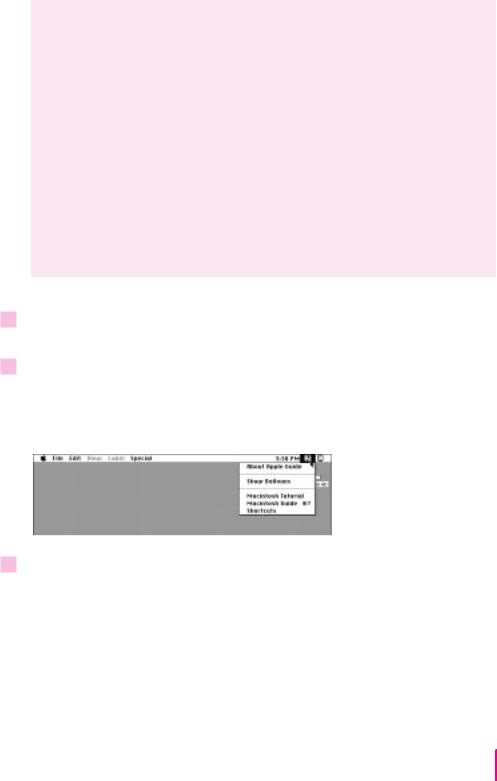
Tips for using the trackpad
For best results when using the trackpad, keep in mind these tips:
mUse your index finger (left or right hand). Use only one finger.
mUse only your finger on the trackpad. Do not use a pen or any other object.
mExtend your PowerBook’s elevation feet when it is placed on a flat surface. This gives your fingers better access to the keyboard and makes it easier to use the tip of your finger on the surface of
the trackpad.
mSometimes humidity or condensation may cause moisture to gather on the trackpad. If this happens, gently wipe the trackpad with a clean cloth before you use it.
2Move your finger on the trackpad so that the tip of the arrow (8) points to the question mark in the upper-right portion of the screen.
3With the tip of the arrow (8) on the question mark, press and hold down the trackpad button.
A list of choices (called a menu) appears. This is the Guide (h) menu, which is the place to go when you have a question about how to use your computer.
4While holding down the trackpad button, move the arrow (8) until the words “Macintosh
Tutorial” are highlighted, then release the trackpad button.
A window appears welcoming you to the tutorial. You can set aside this book for now and follow the instructions you see on the screen. When you have completed the tutorial, return to this book.
Getting Started |
17 |
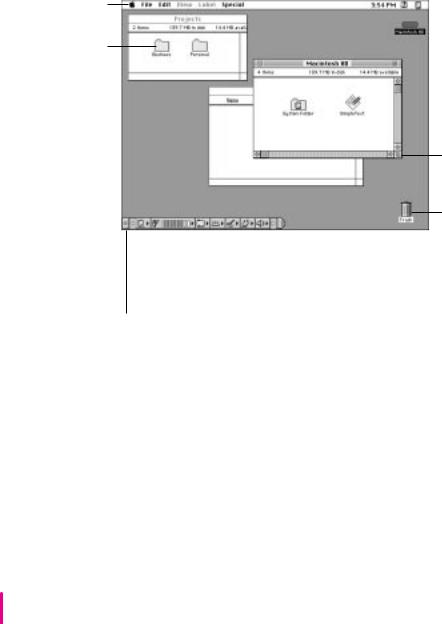
Reviewing the basics
The strip across the top of the screen is called the menu bar. The symbols and words in it represent menus of commands.
Icons are small pictures that represent disks, folders, programs, and documents. To open an icon, click the icon twice quickly.
Windows are boxes that display text, graphics, or icons. To bring a partially covered window to the front, click anywhere in the window.
The following illustration summarizes many of the basic skills and terms you learned from the tutorial.
|
|
|
You can have several application |
|
|
To find an answer to |
programs open at once. To see which |
||
|
program is active or to switch from |
|||
To move a window, |
a question, look in the |
one program to another, use this |
||
drag it by the title bar. |
Guide (h) menu. |
|
menu (called the Application menu). |
|
|
|
|
|
This icon represents your |
|
|
|
|
|
|
|
|
|
computer’s internal hard disk. |
|
|
|
|
|
|
|
|
|
To close a window, |
|
To bring hidden portions of a |
|
|
|||
click the close box. |
window’s contents into view, |
||
|
|
|
click the scroll arrows. |
To change the size or shape of a window, drag the size box.
To throw away an item you no longer want, drag it to the Trash and choose Empty Trash from the Special menu.
The Control Strip gives you a quick and easy way to monitor and update your PowerBook’s power management options. For instructions on using the Control Strip, see the “Batteries & Power” topic of Macintosh Guide, available in the Guide (h) menu.
18 Chapter 1
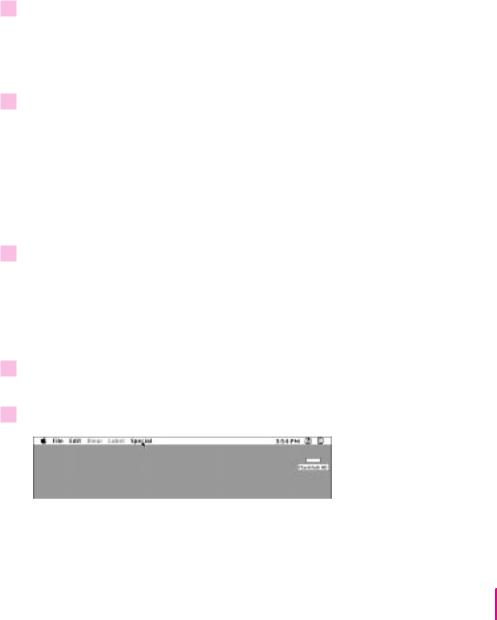
Turning the computer off
Always use one of the following methods to shut down the computer. If you don’t, you risk losing any work you haven’t previously saved on a disk. You also risk losing any open documents.
Turning the computer off with the Power key
To turn the computer off, press the Power key. Detailed instructions follow.
1If the computer is in sleep, press the Power key (or any key on the keyboard except Caps Lock) to wake it.
For information on the sleep feature of your Macintosh PowerBook, see “Putting the Computer to Sleep,” next.
2Press and hold the Power key for about two seconds.
The following dialog box appears on the screen:
3 Press the Return key on the keyboard (or click the Shut Down button in the dialog box).
Turning the computer off with the Shut Down command
You can also turn your computer off by using the Shut Down command in the Special menu. Follow these steps:
1If the computer is in sleep, press the Power key (or any key on the keyboard except Caps Lock) to wake it.
2Move the tip of the arrow to the word “Special” at the top center of the screen.
If the word “Special” does not appear at the top of the screen, you’re not working in the Finder. Choose Finder from the Application menu at the far-right end of the menu bar.
Getting Started |
19 |
